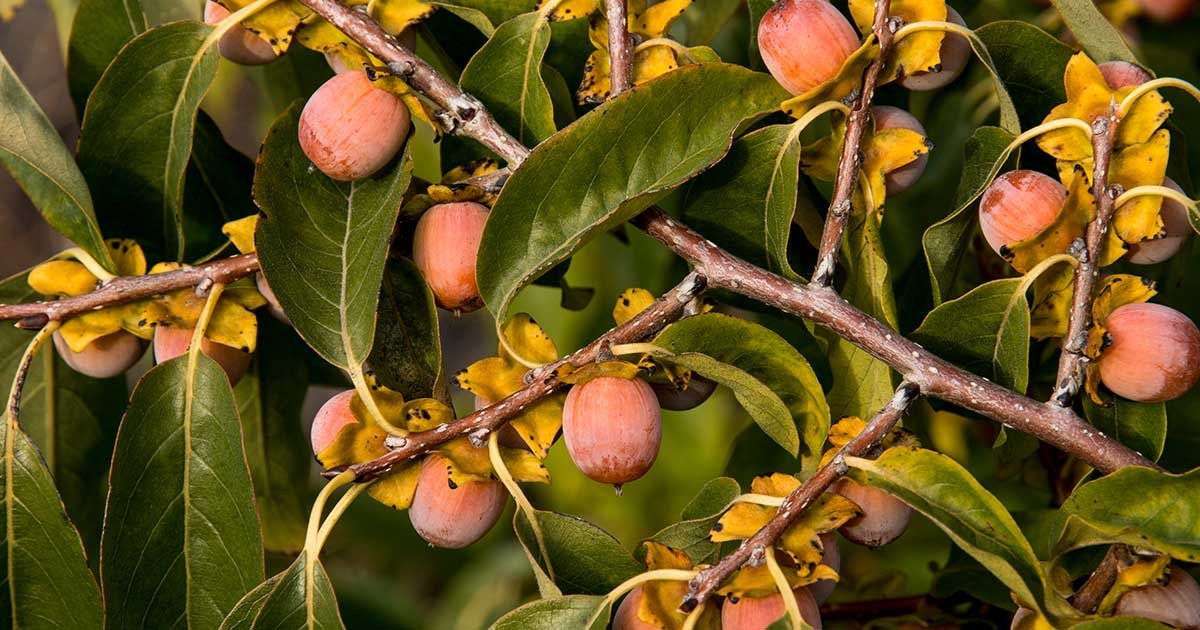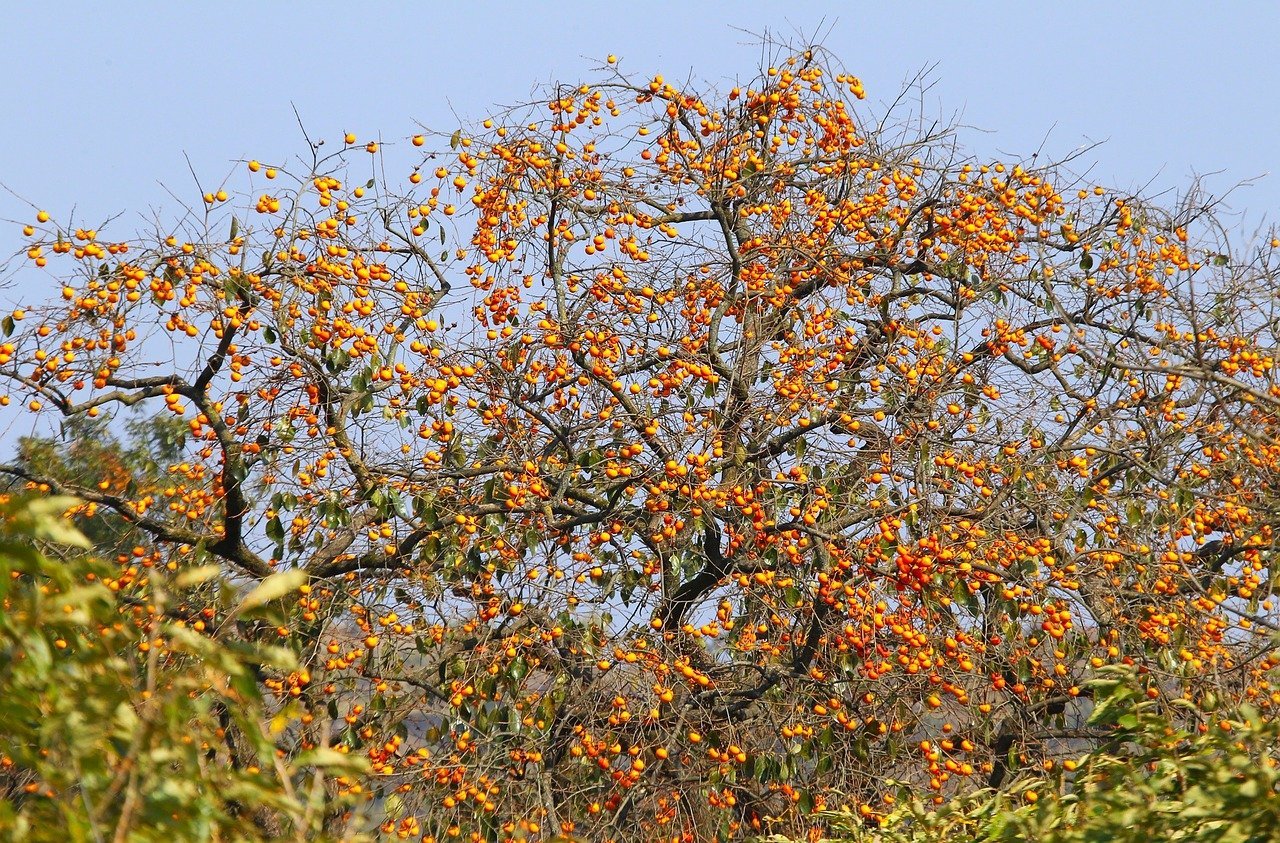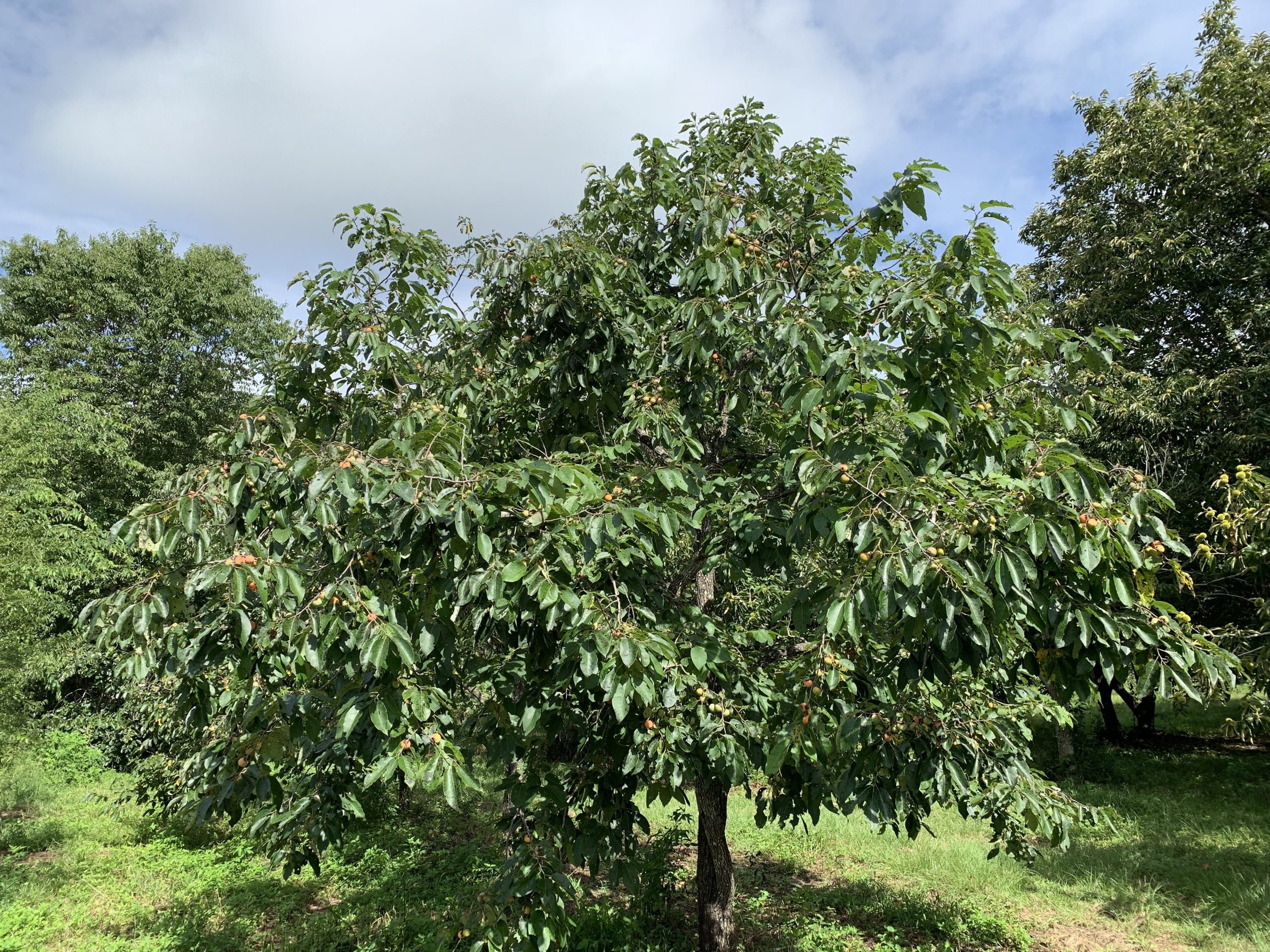American Persimmon
Dysporus virginiana. The scientific name translates to ‘Fruit of the Gods’ and there is good reason. The American persimmon has unique potential as an agrofrestry crop. Fruits typically ripen in August and can stay on the tree through October, sometimes into early January. As they dry on the tree, the sugars concentrate and the fruits become even sweeter offering up to 6 months of forage for wildlife and grazing animals that can last into the leanest parts of the year.
It’s native range is New England to Florida and west to Texas, Louisiana, Oklahoma and Kansas with two different races - a 60-chromosome (tetraploid) southern variety and a 90-chromosome (hexaploid) northern variety loosely split in range along the Ohio River but with overlap. Kaki - the Asian cousin - has had centuries of improvement through breeding, but American persimmon has had very little modern breeding attention. There is emerging evidence of early breeding efforts by Native Americans in the southeast and some places have even developed deep culinary traditions around their use. But, most of the named cultivars we know of are considered chance seedlings. They have native pollinator friends and very few serious pests and diseases and trees can be expected to bear heavy crops of fruit every year with little to no care.
The taste of the fruit is altogether different than the kaki which was the most widely grown fruit in East Asia until the 20th century. Though relished by Native Americans, American persimmon has never been embraced as a commercial fruit crop because it bruises too easily. Compared to the kaki, the American persimmon is more cold-hardy, softer, dryer, but with a richer flavor. It is also higher in nutrients like vitamin C and calcium.
Persimmon trees are usually dioecious (either male or female), but some have complete flowers that make them self-fruitful. They are somewhat unique in that sexual expression can vary from year to year. Trees remain dormant longer than most fruit trees, and blossoming is relatively late in the season and rarely damaged by late-spring frosts. 3-6 trees are recommended. If left unpruned it can grow from 30-75 FT but most are managed at smaller heights for production. The tree can tolerate a wide range of soils but warm and sandy are preferred. It can also tolerate a wide range of moisture except for completely waterlogged soils. American persimmon are high in soluble tannins until they are thoroughly ripe. Unripe fruit is extremely astringent, but throughly ripened fruit is sweet and delicious. They can be eaten fresh, dried or cooked into pies, cookies and cakes.
virginiana: Northern 90-chromosome strain. These are vigorous seedlings grown from the best American persimmons sourced from all-cultivar orchards.
Morris Burton: A wild selection discovered by cows in Indiana. The Burtons had a large farm covered with persimmon trees, but all the animal trails led to this tree. When the owners tasted the fruit, they found out why it was so popular. The fruit is small and the flesh a beautiful red, but all who have tasted this one agree that it has the best flavor. The sugar content is so high that you can cut the sugar added in recipes by 50% and get the required results. The foliage turns bright yellow in the fall and is very ornamental looking. It is precocious and bares large annual crops.
Prok: Thought by many to be an Asian/American hybrid due to the fruit size being 30% larger than other American cultivars, ‘Prok’ is a pure 90 chromosome American persimmon from the mother ‘Pipher.’ The name comes from the acronym for ‘Persimmon Ralph Kreider’ who originally found ‘Pipher’ in Northern Illinois. ‘Prok’ has the highest flesh to seed ratio of any pollinated 90 chromosome persimmon and at 8 fruits to the pound, is thought to be the most viable American cultivar for commercial production. For Northern climates, ‘Prok’ is one of the earliest dropping cultivars and is well known to ripen before winter sets in.
Juhl: One of the best pulping persimmons available, as it falls freely from the tree without its calyx and has a large flesh/seed ratio, often producing around 70% pulp. The fruit is large to very large and one of the earliest to ripen, usually in early-mid September. The fruit color is clear yellow with a slight red blush and heavy bloom. ‘Juhl’ has tender skin and flesh without astringency when ripe. She is a regular heavy bearer with an average of 10 fruits to the pound.
Sold as bare root seedlings 18-36” tall.
Dysporus virginiana. The scientific name translates to ‘Fruit of the Gods’ and there is good reason. The American persimmon has unique potential as an agrofrestry crop. Fruits typically ripen in August and can stay on the tree through October, sometimes into early January. As they dry on the tree, the sugars concentrate and the fruits become even sweeter offering up to 6 months of forage for wildlife and grazing animals that can last into the leanest parts of the year.
It’s native range is New England to Florida and west to Texas, Louisiana, Oklahoma and Kansas with two different races - a 60-chromosome (tetraploid) southern variety and a 90-chromosome (hexaploid) northern variety loosely split in range along the Ohio River but with overlap. Kaki - the Asian cousin - has had centuries of improvement through breeding, but American persimmon has had very little modern breeding attention. There is emerging evidence of early breeding efforts by Native Americans in the southeast and some places have even developed deep culinary traditions around their use. But, most of the named cultivars we know of are considered chance seedlings. They have native pollinator friends and very few serious pests and diseases and trees can be expected to bear heavy crops of fruit every year with little to no care.
The taste of the fruit is altogether different than the kaki which was the most widely grown fruit in East Asia until the 20th century. Though relished by Native Americans, American persimmon has never been embraced as a commercial fruit crop because it bruises too easily. Compared to the kaki, the American persimmon is more cold-hardy, softer, dryer, but with a richer flavor. It is also higher in nutrients like vitamin C and calcium.
Persimmon trees are usually dioecious (either male or female), but some have complete flowers that make them self-fruitful. They are somewhat unique in that sexual expression can vary from year to year. Trees remain dormant longer than most fruit trees, and blossoming is relatively late in the season and rarely damaged by late-spring frosts. 3-6 trees are recommended. If left unpruned it can grow from 30-75 FT but most are managed at smaller heights for production. The tree can tolerate a wide range of soils but warm and sandy are preferred. It can also tolerate a wide range of moisture except for completely waterlogged soils. American persimmon are high in soluble tannins until they are thoroughly ripe. Unripe fruit is extremely astringent, but throughly ripened fruit is sweet and delicious. They can be eaten fresh, dried or cooked into pies, cookies and cakes.
virginiana: Northern 90-chromosome strain. These are vigorous seedlings grown from the best American persimmons sourced from all-cultivar orchards.
Morris Burton: A wild selection discovered by cows in Indiana. The Burtons had a large farm covered with persimmon trees, but all the animal trails led to this tree. When the owners tasted the fruit, they found out why it was so popular. The fruit is small and the flesh a beautiful red, but all who have tasted this one agree that it has the best flavor. The sugar content is so high that you can cut the sugar added in recipes by 50% and get the required results. The foliage turns bright yellow in the fall and is very ornamental looking. It is precocious and bares large annual crops.
Prok: Thought by many to be an Asian/American hybrid due to the fruit size being 30% larger than other American cultivars, ‘Prok’ is a pure 90 chromosome American persimmon from the mother ‘Pipher.’ The name comes from the acronym for ‘Persimmon Ralph Kreider’ who originally found ‘Pipher’ in Northern Illinois. ‘Prok’ has the highest flesh to seed ratio of any pollinated 90 chromosome persimmon and at 8 fruits to the pound, is thought to be the most viable American cultivar for commercial production. For Northern climates, ‘Prok’ is one of the earliest dropping cultivars and is well known to ripen before winter sets in.
Juhl: One of the best pulping persimmons available, as it falls freely from the tree without its calyx and has a large flesh/seed ratio, often producing around 70% pulp. The fruit is large to very large and one of the earliest to ripen, usually in early-mid September. The fruit color is clear yellow with a slight red blush and heavy bloom. ‘Juhl’ has tender skin and flesh without astringency when ripe. She is a regular heavy bearer with an average of 10 fruits to the pound.
Sold as bare root seedlings 18-36” tall.
Dysporus virginiana. The scientific name translates to ‘Fruit of the Gods’ and there is good reason. The American persimmon has unique potential as an agrofrestry crop. Fruits typically ripen in August and can stay on the tree through October, sometimes into early January. As they dry on the tree, the sugars concentrate and the fruits become even sweeter offering up to 6 months of forage for wildlife and grazing animals that can last into the leanest parts of the year.
It’s native range is New England to Florida and west to Texas, Louisiana, Oklahoma and Kansas with two different races - a 60-chromosome (tetraploid) southern variety and a 90-chromosome (hexaploid) northern variety loosely split in range along the Ohio River but with overlap. Kaki - the Asian cousin - has had centuries of improvement through breeding, but American persimmon has had very little modern breeding attention. There is emerging evidence of early breeding efforts by Native Americans in the southeast and some places have even developed deep culinary traditions around their use. But, most of the named cultivars we know of are considered chance seedlings. They have native pollinator friends and very few serious pests and diseases and trees can be expected to bear heavy crops of fruit every year with little to no care.
The taste of the fruit is altogether different than the kaki which was the most widely grown fruit in East Asia until the 20th century. Though relished by Native Americans, American persimmon has never been embraced as a commercial fruit crop because it bruises too easily. Compared to the kaki, the American persimmon is more cold-hardy, softer, dryer, but with a richer flavor. It is also higher in nutrients like vitamin C and calcium.
Persimmon trees are usually dioecious (either male or female), but some have complete flowers that make them self-fruitful. They are somewhat unique in that sexual expression can vary from year to year. Trees remain dormant longer than most fruit trees, and blossoming is relatively late in the season and rarely damaged by late-spring frosts. 3-6 trees are recommended. If left unpruned it can grow from 30-75 FT but most are managed at smaller heights for production. The tree can tolerate a wide range of soils but warm and sandy are preferred. It can also tolerate a wide range of moisture except for completely waterlogged soils. American persimmon are high in soluble tannins until they are thoroughly ripe. Unripe fruit is extremely astringent, but throughly ripened fruit is sweet and delicious. They can be eaten fresh, dried or cooked into pies, cookies and cakes.
virginiana: Northern 90-chromosome strain. These are vigorous seedlings grown from the best American persimmons sourced from all-cultivar orchards.
Morris Burton: A wild selection discovered by cows in Indiana. The Burtons had a large farm covered with persimmon trees, but all the animal trails led to this tree. When the owners tasted the fruit, they found out why it was so popular. The fruit is small and the flesh a beautiful red, but all who have tasted this one agree that it has the best flavor. The sugar content is so high that you can cut the sugar added in recipes by 50% and get the required results. The foliage turns bright yellow in the fall and is very ornamental looking. It is precocious and bares large annual crops.
Prok: Thought by many to be an Asian/American hybrid due to the fruit size being 30% larger than other American cultivars, ‘Prok’ is a pure 90 chromosome American persimmon from the mother ‘Pipher.’ The name comes from the acronym for ‘Persimmon Ralph Kreider’ who originally found ‘Pipher’ in Northern Illinois. ‘Prok’ has the highest flesh to seed ratio of any pollinated 90 chromosome persimmon and at 8 fruits to the pound, is thought to be the most viable American cultivar for commercial production. For Northern climates, ‘Prok’ is one of the earliest dropping cultivars and is well known to ripen before winter sets in.
Juhl: One of the best pulping persimmons available, as it falls freely from the tree without its calyx and has a large flesh/seed ratio, often producing around 70% pulp. The fruit is large to very large and one of the earliest to ripen, usually in early-mid September. The fruit color is clear yellow with a slight red blush and heavy bloom. ‘Juhl’ has tender skin and flesh without astringency when ripe. She is a regular heavy bearer with an average of 10 fruits to the pound.
Sold as bare root seedlings 18-36” tall.




